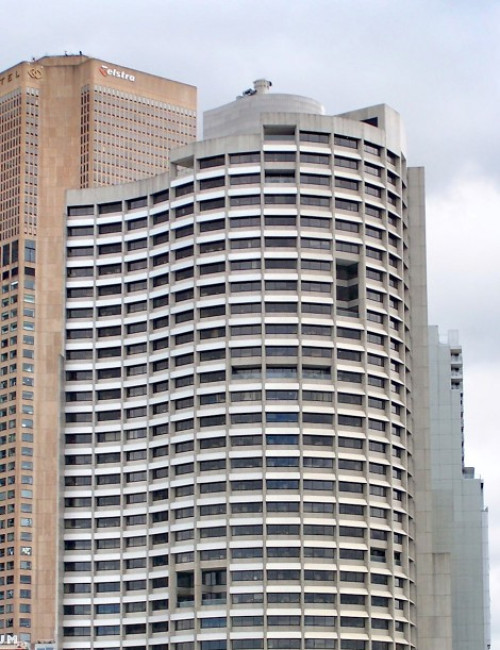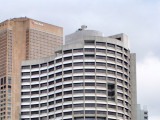1 Spring Street
Melbourne
- Facts
-
Metrics
You must be a CTBUH Member to view this resource.
Official Name
1 Spring Street
Other Names
Shell House
Type
Building
Status
Completed
Completion
1988
Country
City
Address
Function
A mixed-use tall building contains two or more functions (or uses), where each of the functions occupy a significant proportion of the tower's total space. Support areas such as car parks and mechanical plant space do not constitute mixed-use functions. Functions are denoted on CTBUH "Tallest Building" lists in descending order, e.g., "hotel/office" indicates hotel function above office function.
Office
Structural Material
Both the main vertical/lateral structural elements and the floor spanning systems are constructed from steel. Note that a building of steel construction with a floor system of concrete planks or concrete slab on top of steel beams is still considered an “all-steel” structure as the concrete elements are not acting as the primary structure.
All-Concrete
Both the main vertical/lateral structural elements and the floor spanning systems are constructed from concrete which has been cast in place and utilizes steel reinforcement bars and/or steel reinforced concrete which has been precast as individual components and assembled together on-site.
All-Timber
Both the main vertical/lateral structural elements and the floor spanning systems are constructed from timber. An all-timber structure may include the use of localized non-timber connections between timber elements. Note that a building of timber construction with a floor system of concrete planks or concrete slab on top of timber beams is still considered an “all-timber” structure as the concrete elements are not acting as the primary structure.
Mixed-Structure
Utilizes distinct systems (e.g. all-steel, all-concrete, all-timber), one on top of the other. For example, a Steel Over Concrete indicates an all-steel structural system located on top of an all-concrete structural system, with the opposite true of Concrete Over Steel.
Composite
A combination of materials (e.g. steel, concrete, timber) are used together in the main structural elements. Examples include buildings which utilize: steel columns with a floor system of reinforced concrete beams; a steel frame system with a concrete core; concrete-encased steel columns; concrete-filled steel tubes; etc. Where known, the CTBUH database breaks out the materials used within a composite building’s primary structural elements.
All-Concrete
Height
132 m / 433 ft
Floors Above Ground
32
Rankings
-
By function
You must be a CTBUH Member to view this resource.
-
By material
You must be a CTBUH Member to view this resource.
Construction Schedule
Construction Start
Completed
You must be a CTBUH Member to view this resource.
Architect
Usually involved in the front end design, with a "typical" condition being that of a leadership role through either Schematic Design or Design Development, and then a monitoring role through the CD and CA phases.
Harry Seidler and Associates
Contractor
The main contractor is the supervisory contractor of all construction work on a project, management of sub-contractors and vendors, etc. May be referred to as "Construction Manager," however, for consistency CTBUH uses the term "Main Contractor" exclusively.
Grocon
About 1 Spring Street
Originally known as Shell House, 1 Spring Street was erected as the third headquarters for the Shell Company of Australia Ltd and replaced the earlier headquarters buildings constructed in 1933 and 1958 and remained occupied by Shell until 2004. Located on an L-shaped site at the southeastern corner of the central Melbourne city grid, the curved façade turns the corner of the block, creating a bookend for the urban street wall facing the Treasury and Fitzroy Gardens at the edge of the traditional central business district, while maximizing views to the south and east. 1 Spring Street is the only completed high-rise project by Australian modernist architect Harry Seidler within the State of Victoria and was composed of simple geometry, typical of late twentieth century office towers with an emphasis on expressing the structure of the reinforced concrete building.
The main entrance of the building is located on a public plaza and is demarcated with a sculptural building pier facing the intersection of Spring and Flinders Streets. The office tower was constructed with repetitive floors utilizing a system of clear span beams of equal length; maintaining a 15 meter wide column free span from the perimeter wall to the internal building core. The top two office floors were designed as executive suites with terrace gardens positioned at two upper level setbacks. The façade is composed of concrete sheer walls to the north and west while windows were primarily positioned to the southeast and flanked by anti-glare aluminum shades to reduce solar heat gain. These passive sustainable design features were also supplemented by daylight sensors and motion detectors to activate interior lighting, and were innovative for their time.
Subscribe below to receive periodic updates from CTBUH on the latest Tall Building and Urban news and CTBUH initiatives, including our monthly newsletter. Fields with a red asterisk (*) next to them are required.
View our privacy policy


